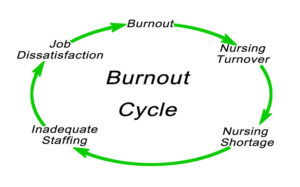By Rose O. Sherman, EdD, RN, NEA-BC, FAAN
A new nurse manager recently sought guidance from me on how much time she spent in direct care. Her unit is very short-staffed. She feels guilty about her nurse-patient ratios. Her solution has been to do direct care herself. The staff love that she is so supportive of her. But here is the problem, she is burning out. She has no time to do her administrative work, has fallen behind in scheduling recruitment interviews, and feels like a failure in the manager role. She brings her administrative work home and gets texts from staff 24/7.
This manager’s story is crucial to how new leaders struggle with work-life balance after assuming the role, especially now. Staffing is so short in many health systems that leaders find themselves getting sucked into the staffing vortex – some every day. Many have young families working well into the evening hours, often ignoring their children and spouses.
For many nurse leaders, the most challenging parts of the job are managing themselves and putting boundaries around their work. This is especially true for new leaders who are struggling to accomplish everything that is expected of them in their leadership roles. It is not uncommon to find that some leaders work 10-12 hours each day, and then continue to answer texts and emails on the weekend.
The problem with not having boundaries is that the pace of work can become unsustainable. Left unchecked, new managers often feel that the only way out is to leave the position. We have a culture in many settings today where this level of direct care is now an expectation of leaders. The fallout of this is seen with staff, many of whom are burned out and disengaged. Nurses look to their leaders to role model good work-life balance, but they often see quite the opposite.
My answer to this leader is that she cannot routinely take patient care assignments and expect to be successful in the role. Spending an hour or two out on the unit supporting staff with their assignments differs from taking a full patient care assignment. We should not expect this from our leaders. Four recommended steps in setting boundaries include the following:
- Identify your limits – we are often our own worst enemies when it comes to working and can have challenges saying no. Getting clear about your limits–emotional, mental, physical, spiritual, etc. is an essential first step. Limits are a very individual thing and may vary considerably among leaders depending on their stage of life.
- Pay attention to your feelings – feelings are an influential gauge of whether we have moved into overdrive with our work. Pay very close attention when you feel discomfort, resentment, and/or guilt. These feelings are often cues to yourself that a boundary issue may be present. If you have these feelings repeatedly, then it is time to restructure your boundaries.
- Permit yourself to set boundaries – nurse leaders often feel that they should cope with a situation and say yes because that is what they are expected to do. You may question whether you even have the right or deserve to set boundaries in the first place. When these doubts occur, reaffirm to yourself that you do indeed have this right, so permit yourself to do so and work to preserve them. The only one that can set boundaries on your work is you.
- Consider your environment – work environment context plays a key role in how comfortable leaders may be in setting boundaries. Your environment can either support your setting boundaries–making it easier for you–or present obstacles to boundary setting–making it more challenging for you. Nurse executives play such a key role in making it OK (even demanding it) for their leaders to set boundaries.
I am sure that this manager is not alone with the question of when to step in and when to step back. Consider beginning your next leadership meeting with the question, “how do you make decisions today about when to take a direct care assignment? I have learned that nurse managers learn best from each other. Take the time to help them reflect on what they are doing and listen to the experiences of others.
© emergingrnleader.com 2021
Our Most Popular Right Now – Become the Boss No One Wants to Leave Nurse Retention in Turbulent Times
Give your leadership team the gift of a highly rated webinar – Nursing Leadership in 2021: Rebooting after a Life-Quake A Nursing Leadership Reboot Workshop.
Read the Nurse Leader Coach – Available at Amazon and Other Book Sellers.
Recommended Book by the Association of Critical Care Nurses – The Nuts and Bolts of Nursing Leadership: Your Toolkit for Success




 LinkedIn
LinkedIn Instagram
Instagram